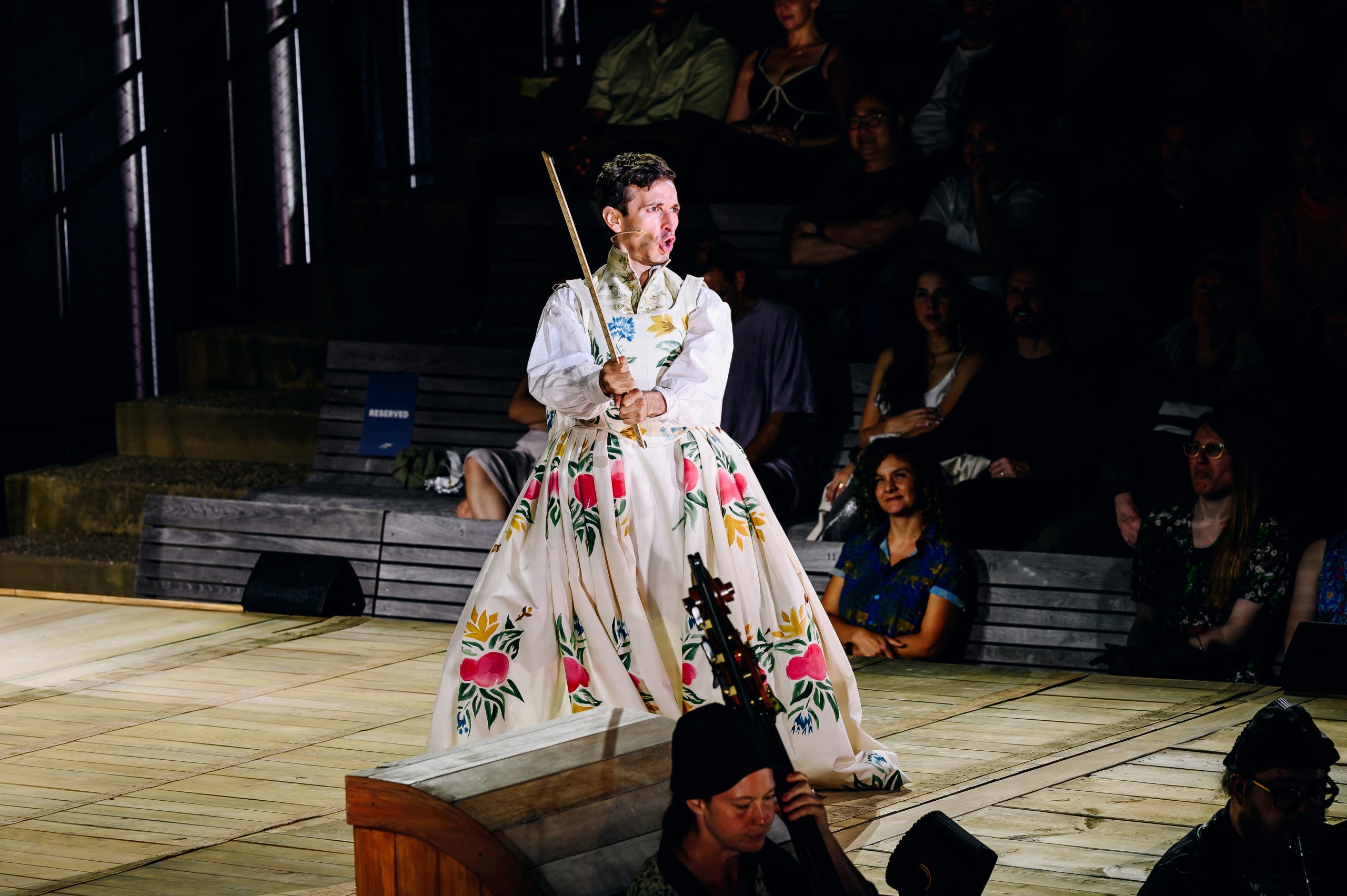Here’s the pitch: countertenor Anthony Roth Costanzo will perform Marriage of Figaro at Little Island. He’ll sing all the parts. However will he do it?
The answer is that he doesn’t do it alone. While the title card reads “Anthony Roth Costanzo *is* The Marriage of Figaro,” that is not strictly true. For the major ensembles, Costanzo sings atop with tracks of himself. For the dramatic action, he has a troupe of actors—Chris Bannow, Daniel Liu, Ryan Shinji Murray, Emma Ramos and Ariana Venturi—play off him, serving as stage hands, supernumeraries, ventriloquist dummies and, yes, as co-stars.
Without them, the central concept could not have sustained itself for ninety minutes, both because this was a flexible, funny ensemble that added plenty of life to the show and because a purely solo show would have quickly grown tiring for the audience and for Costanzo. The expected screwball bit with Costanzo switching hats and costumes at lightning speed only lasted for the first, breathless act. After that, the opera is largely done by lip-synch, with Costanzo sometimes actively part of the drama and sometimes off to the side, a visible or invisible puppet master whose voice enlivened the characters.
Reduced for an eight-piece orchestra and cut to 90 minutes, Costanzo and music director Dan Schlosberg ably and intelligently repackaged Mozart and Da Ponte’s work for Costanzo’s purposes; certain major plot points and minor characters get dropped, but the integral narrative and the most necessary arias and ensembles are all there.

Costanzo’s range is impressive but there were few moments of truly beautiful singing. This is for the all-too-obvious reason that opera singers don’t generally sing bass, baritone, tenor, mezzo-soprano and soprano. Costanzo sounded best when singing Suzanna, worst when singing Cherubino (surprisingly, given it is closest to his usual range), and sang everything else ably enough.
But beautiful singing was not this Figaro’s primary goal; the goal was to make us laugh, dazzle us with Costanzo’s wit and stamina and take a masterpiece apart in playful style. There are plenty of wacky hi-jinks, comedic grace notes, and fun visual gags: the credits sequence with Costanzo’s face photoshopped onto every character, the entire first act with spinning doors and flying costume pieces, some very clever work (and some less so) on the supertitles. The slapstick elements make contact, the comedic timing is on the dot (compliments to director Dustin Wills), and everyone seems to be having a grand old time on stage.
SEE ALSO: Highlights and Early Sales from the Armory Show 2024
I admire the commitment to comedy; so few comedic operas are actually funny in practice, which means credit is due when a production goes for laughs with such zeal. But many of the gags are presented with such an exaggerated, faux-humble cleverness that it feels like an attempt to extract laughter out of the audience instead of inviting us to join in the fun organically. At times, the premise overextends itself, leaving the setup funnier than the payoff.
The Act II finale was Costanzo’s most virtuosic set piece. As the vocal tracks piled up, Costanzo switched between the seven (!) parts, flipping from octave to octave, whirling himself around, before finally standing atop a podium like a demented choir director as the actors scurried around him. It was both the most self-indulgent moment of the show, and to my eye, the best, because Costanzo dispensed with any humble-bragging and straightforwardly showed off.

There are also some absolutely gonzo moments that had mixed results: Sometimes one of the actors accompanied Costanzo on a kazoo. The show grinds to a halt in the middle, as Costanzo, maybe-not-quite feigning exhaustion after the insanity of doing the Act II finale himself, is dragged offstage by EMTs, only to reappear via video singing an aria from the ambulance. Later, Costanzo sings “Dove sono” with a laryngoscope down his throat, so the audience is treated to a closeup of his focal folds smacking together. There’s a spoken dramatic interlude in French, with each actor’s voice processed so it sounded like Darth Vader was attempting to seduce a sassy chipmunk. Antonio the gardener does acrobatic flips on a trampoline in the background of more than one scene.
In the second half, one of the actors pauses the drama again to perform Figaro’s speech from Act V of Beaumarchais’s play, the one that got the playwright censured for its open critique of birthright nobility and which Lorenzo da Ponte cut from his adaptation in favor of an aria wherein Figaro rails against unfaithful women. This attempt to deconstruct Figaro did not fully land, in part because its class politics do not fit in Costanzo’s production and in part because other poignant moments in Mozart’s opera are treated almost uniformly for laughs. Costanzo frames them within a larger visual gimmick, like the laryngoscope in the otherwise heartfelt “Dove Sono.” Yet Suzanna’s “Deh vieni, non tardar” was sung with complete sincerity. Why play this moment so straight, instead of the Countess’s material? I don’t know.
Most of the time, this production felt like an inside joke, one perhaps especially aimed at singers (for whom Figaro is studied with near biblical attention across the country) and superfans, that was, for better and worse, being turned outwards to a general audience. I myself have done similar performances of the opera in my kitchen, singing along with every part—only it was my dishes I enlivened, not an acting troupe. So, it seems I am also The Marriage of Figaro, as is everyone who loves it. But a mid-show summary of the action of the first half also indicated that this performance was also meant even for those less familiar with the opera. What such an audience would get from this performance is less clear, as was Costanzo’s take on the opera. The laughs were often raucous in Little Island’s amphitheater, but the ultimate purpose of the project receded in favor of the intrigue of the pitch.

